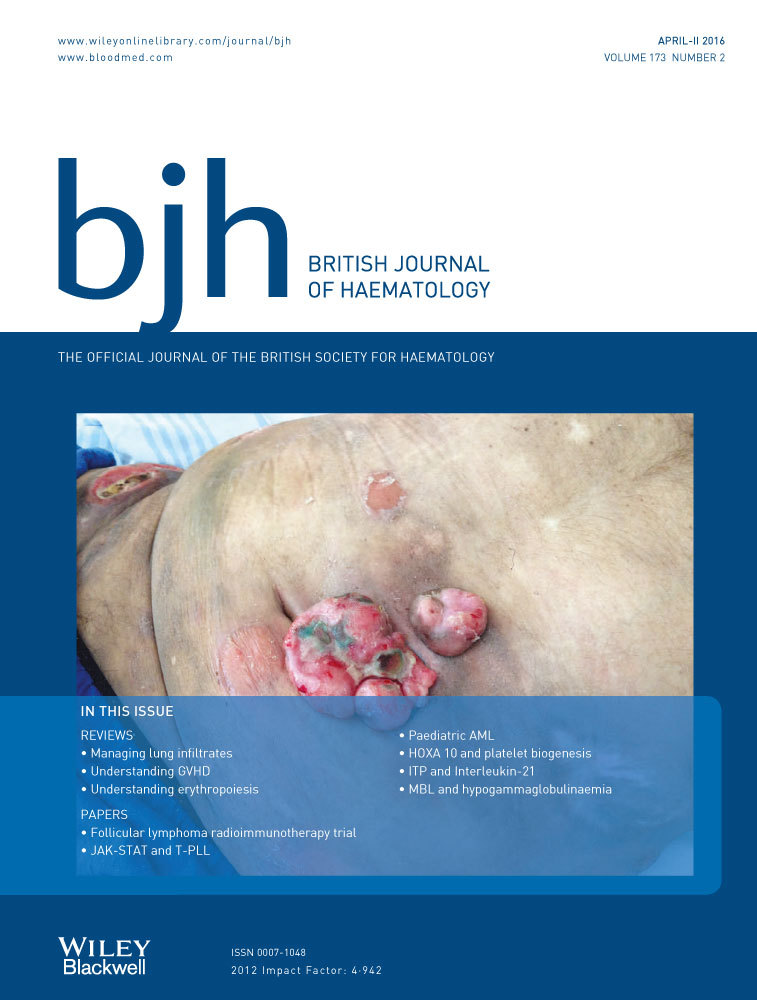Autoimmune haemolytic anaemia occurring during ibrutinib therapy for chronic lymphocytic leukaemia
We read with great interest the recent correspondence from Manda et al (2015) which reported a case where ibrutinib, the first-in-class Bruton tyrosine kinase inhibitor, was used successfully to treat steroid-refractory autoimmune haemolytic anaemia (AIHA) in a patient with chronic lymphocytic leukaemia (CLL). In the 4 weeks prior to treatment with ibrutinib the patient was refractory to 1 mg/kg of prednisolone, and a combination of cyclophosphamide (500 mg/m2) and vincristine (2 mg). This is the first and only report we are aware of utilizing ibrutinib therapy in this setting.
Here we report a case where we believe AIHA developed secondary to ibrutinib therapy, which suggests caution should be employed with the use of ibrutinib in this setting. Our patient initially presented with a Rai Stage IV, 13q- and TP53-deleted CLL with a lymphocytosis of 175·8 × 109/l. Widespread bulky adenopathy and hepatosplenomegaly was demonstrated on computerized tomography (CT) scanning. He was commenced on treatment with alemtuzumab and methylprednisolone for 12 weeks. A molecular cytogenetic remission was demonstrated by normal fluorescence in situ hybridization studies on post-treatment evaluation. However, 0·3% minimal residual disease was demonstrated by 6-colour flow cytometry. In addition, only a partial radiological response was achieved according to RECIST criteria (Eisenhauer et al, 2009), with persistent significant axillary, mediastinal, mesenteric lymphadenopathy and splenomegaly (22 cm) on follow-up CT imaging. He was therefore commenced on ibrutinib therapy due to the partial response to alemtuzumab therapy and TP53 deletion at diagnosis.
Prior to starting ibrutinib the patients' haemoglobin was 149 g/l, there was no past history of AIHA or any other autoimmune complications relating to CLL. A direct Coombs test was also negative at diagnosis. Four weeks after commencing ibrutinib 420 mg daily, he was admitted to our inpatient ward with acute haemolysis. Initial blood tests revealed haemoglobin 53 g/l, bilirubin 107 μmol/l, lactate dehydrogenase 1415 u/l, reticulocytes 538·80 × 109/l with a positive direct Coombs test (IgG 4+, C3d−). His ibrutinib therapy was withheld and 1 mg/kg of prednisolone was commenced. He was transfused with a total of 6 units of red blood cells during his hospital admission. His haemoglobin normalized to 137 g/l after 17 d of treatment. After completing tapered prednisolone therapy, he was recommenced on ibrutinib therapy. In the 3 months since re-initiating ibrutinib there has been no evidence of AIHA recurrence and the widespread lymphadenopathy and hepatosplenomegaly are no longer clinically detectable.
Five to 10 per cent of CLL patients develop autoimmune complications, of which AIHA is the most common (Zent & Kay, 2010). Autoimmune cytopenias in CLL depend on a complex interaction between malignant B-CLL cells, abnormally functioning T-cells and the wider immune system (Hodgson et al, 2011). In AIHA the pathogenic antibodies responsible for 90% of cases are produced by non-malignant B cells, which are polyclonal high affinity IgG antibodies directed against red blood cells (Zent & Kay, 2010). A major limitation in the treatment of AIHA in CLL patients is that the evidence base is mainly formed from retrospective studies and expert opinion (Hodgson et al, 2011). Ibrutinib trials excluded those with uncontrolled haemolysis, as did the majority of CLL trials. With the advanced age and associated multiple comorbities common to many CLL patients, treatment of steroid-refractory AIHA presents a challenge.
Manda et al (2015) presented a case of successfully managing AIHA in CLL with ibrutinib. This new agent has minimal myelosuppressive effects as shown by a 3-year follow-up study of CLL patients receiving ibrutinib in which no patient discontinued therapy due to cytopenias (Byrd et al, 2015). This suggests ibrutinib could be well tolerated in elderly patients with steroid-refractory AIHA in CLL, but no mechanistic explanation or direct evidence that ibrutinib exerts an effect on haemolysis is available. Also, given the strong temporal relationship between initiating ibrutinib and the onset of AIHA in our case, we would not recommend using ibrutinib to treat AIHA until there is sufficient evidence to support this approach. Our case also demonstrates that ibrutinib can be safely reintroduced after an episode of AIHA, without causing recurrence.
Author contributions
TGR wrote the manuscript. JAN & RJG critically revised the manuscript.
Conflict of interest
No conflict of interest.




